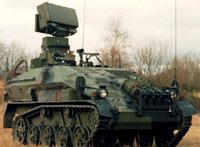LPI-Radar
LPI radar („Low Probability of Intercept”) is a class of radar systems that possess certain performance characteristics that make them nearly undetectable by today's intercept receivers. A low probability of intercept features prevents the radar from tripping off alarm systems or passive radar-detection equipment in a target. These features include:

Figure 1: HARD, a „silent radar” in the German LeFlaSys system via STN ATLAS Elektronik GmbH
- using an antenna with a narrow beam and low side lobes that are hard to spot from off its boresight;
- only transmitting radar pulses when necessary;
- reducing the transmitted pulse-power;
- spreading the radar pulses over a wide band so there will only be a very small signal on any one band; or
- varying transmission parameters such as
- pulse form,
- frequency, or
- pulse repetition frequency (PRF),
- using an intrapulse modulation with an inconspicuously wave-form (e.g. a pseudo-random bit pattern).
The function of an LPI radar is to prevent its interception by an Electronic Support receiver. This objective is generally achieved through the use of a radar waveform that is mismatched to those waveforms for which an Electronic Support receiver is tuned. Consequently, a conventional Electronic Support receiver can only detect an LPI radar at very short ranges.
The LPI radar transmits a low power intrapulse modulated waveform so that the range of the detected target can be determined with a good range resolution. This modulation may be phase or frequency modulated or pseudo-random and noise like modulation. A typical LPI radar has a switchable pulse-power output of up to 1 Watt. A conventional pulse radar needs at least 10 kW for a similar detection range of targets. This allows the LPI radar to achieve a processing gain, with respect to an Electronic Support receiver, that is equal to the time-bandwidth product of the radar waveform. This processing gain allows the LPI radar as a primary radar and fourth-root dependence of the two way travel of electromagnetic waves, to overcome the range-squared advantage of the Electronic Support receiver in conventional situations.
However, LPI radars are limited to short range applications. A relatively long transmitted pulse width still applies to the transmission, which requires the duplexer to remain aligned to the transmitter throughout the pulse and the receiver is switched off during this time. Therefore many LPI radars have separate transmit and receive antennas that are co-mounted. Some recent LPI radars can use instead of the pulse radar technology an FMCW- mode to reduce the transmitted power substantially.
LPI radar sensor, LPI Radar Detector, radar warning receiver, Electronic Support system, fmcw radar sensor front end
